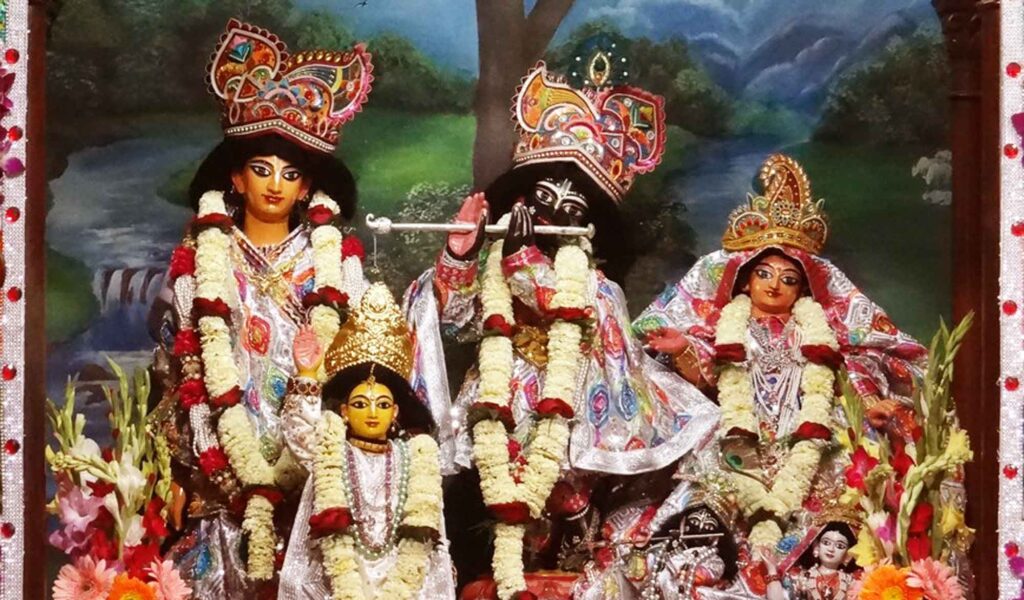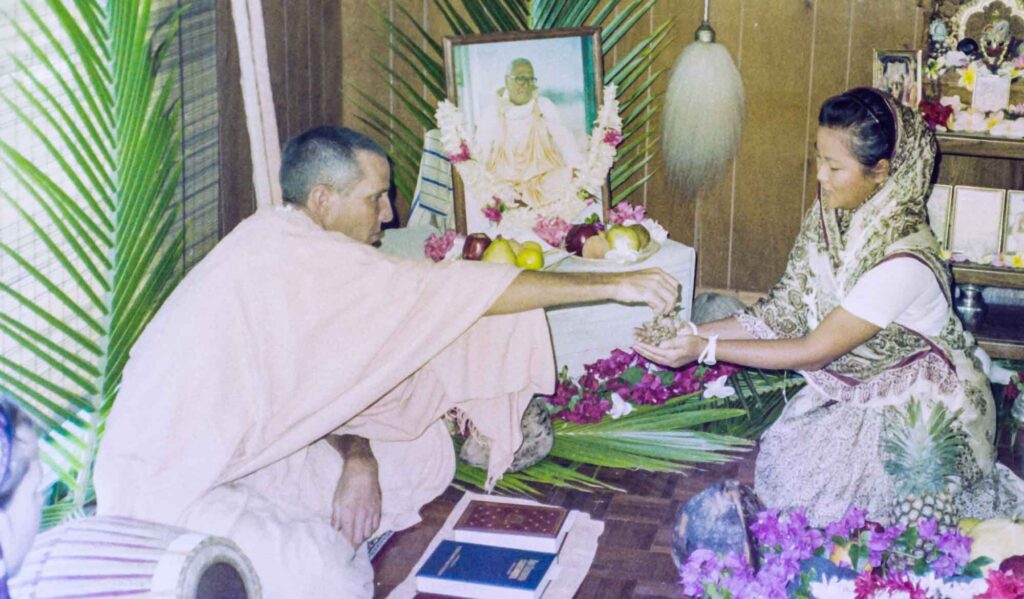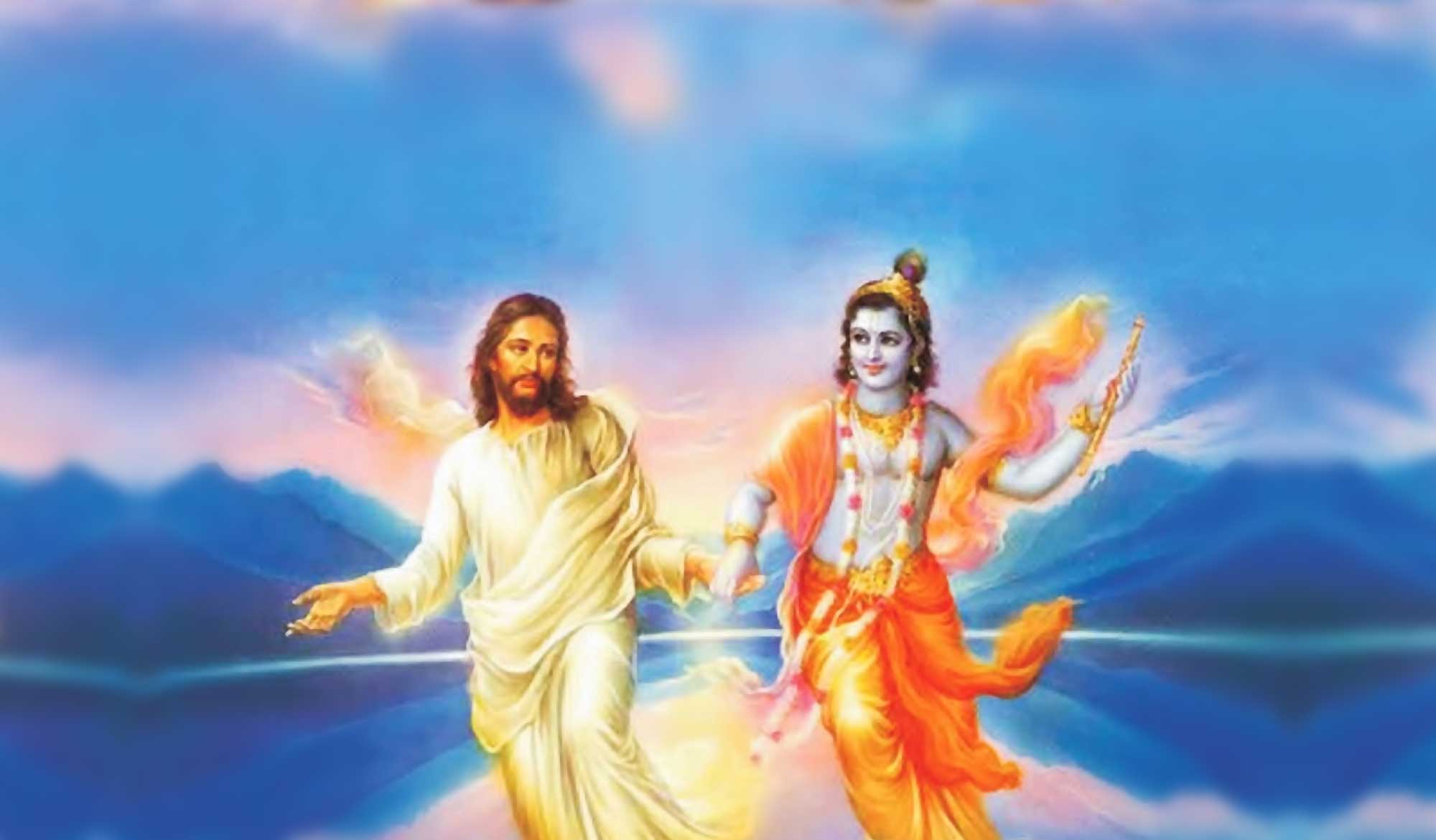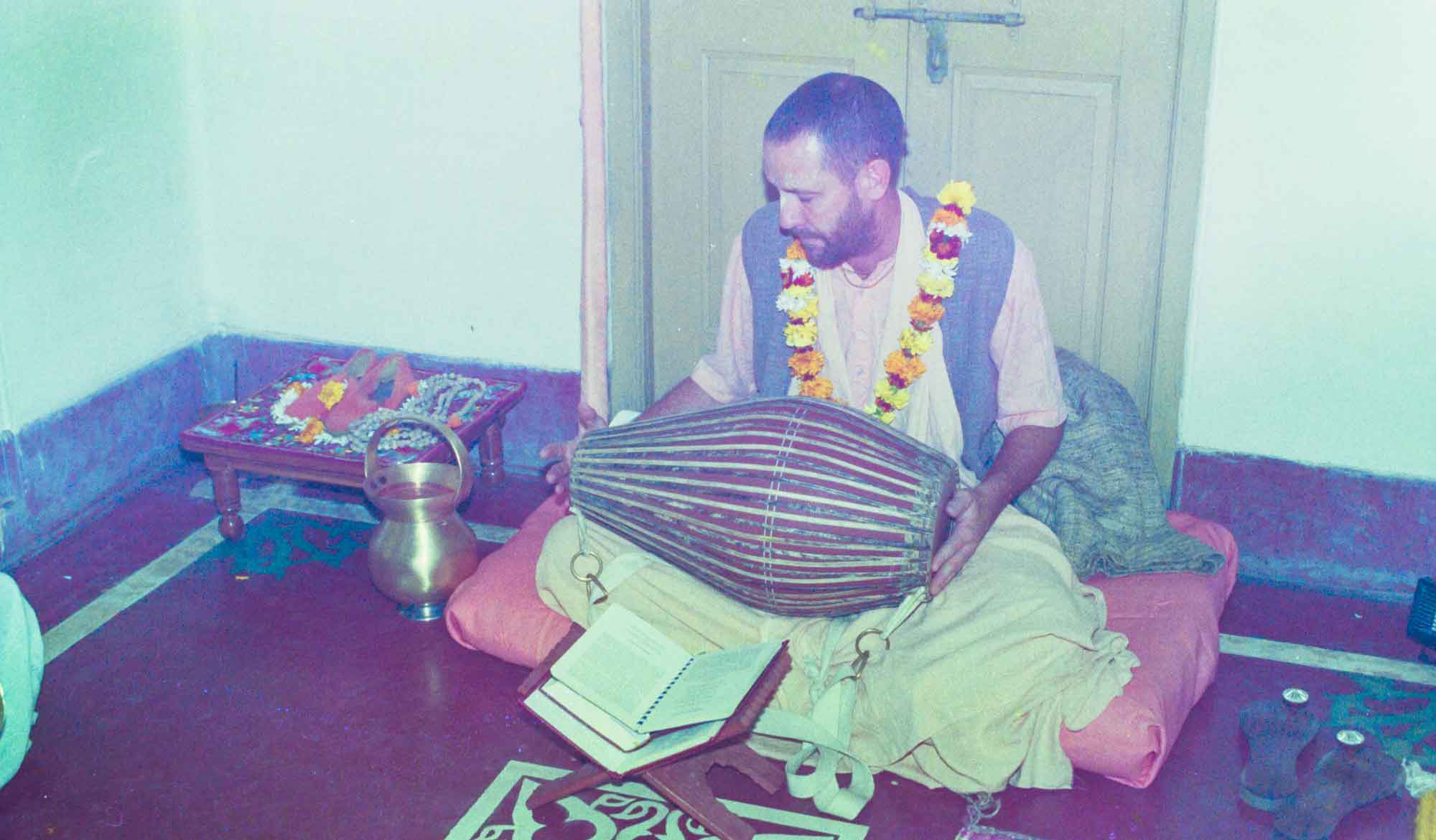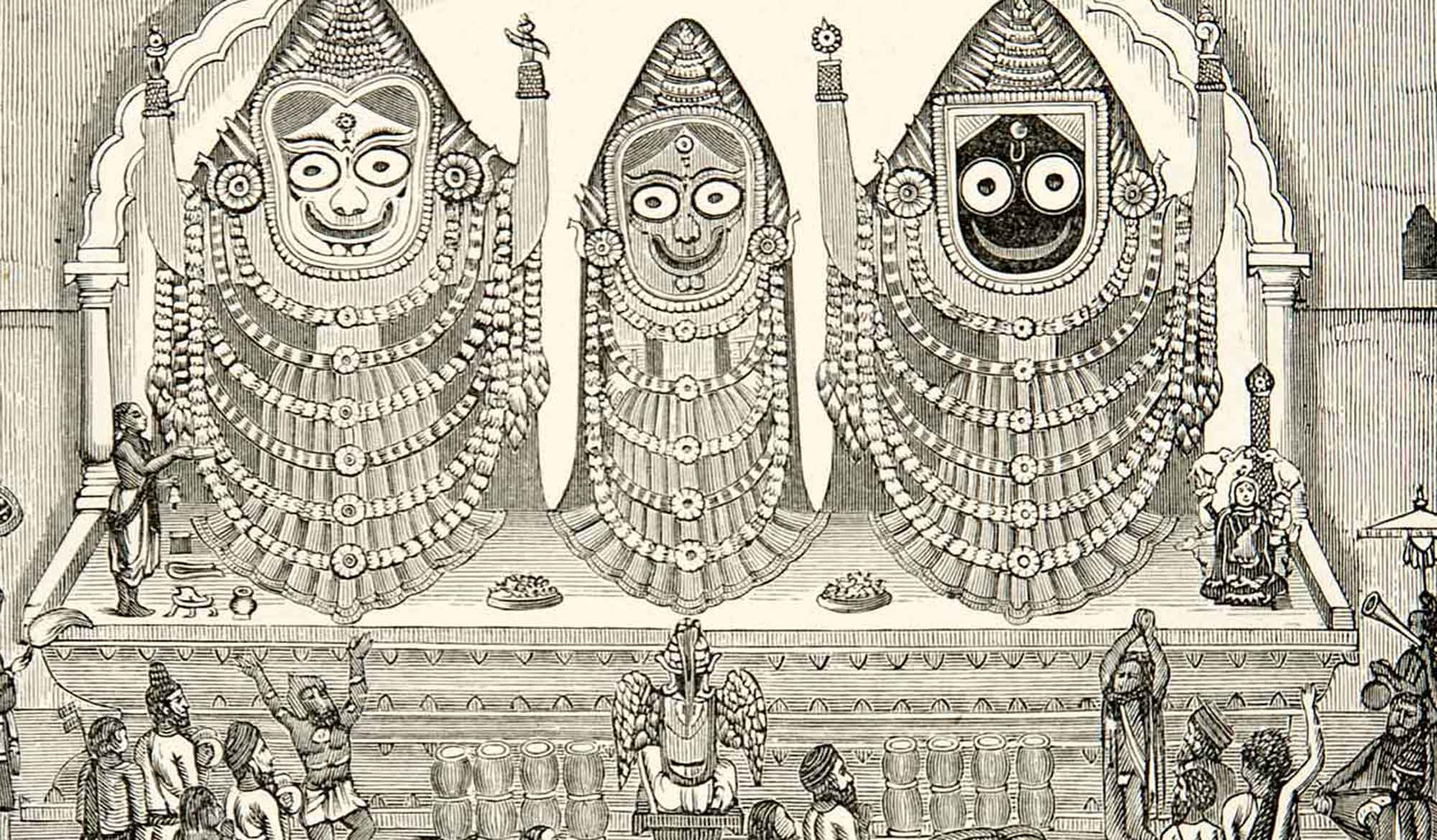by Swami B.G. Narasingha
“Gāyatrī as Rādhārāṇī” was written by Śrīla B.G. Narasiṅgha Mahārāja in October 2003. Narasiṅgha Mahārāja briefly explains the Gāyatrī-Nigūḍhārtha composed by Śrīla Śridhara Mahārāja which shows how the brahma-gāyatrī ultimately refers to Śrīmatī Rādhārāṇī.
Question: I have read in an article that brahma–gāyatrī worships Śrīmatī Rādhārāṇī. Where does this conception have its origin?
Answer: The origin of gāyatrī is Kṛṣṇa Himself and therefore the conception of gāyatrī worshiping Śrīmatī Rādhārāṇī finds its primeval origin in Kṛṣṇa. The meaning of brahma–gāyatrī is self-effulgent; “Above the three planes of mundane experience, bhūr, bhuvaḥ, svaḥ, is the soul, savitur, who shows us everything just like the sun. Above the soul is the super-subjective plane which is vareṇyam, most venerated and worshipable. That worshipable plane of existence is called bhargo, brilliant and illuminating. The super-subjective area, bhargo, is the plane known as the svarūpa–śakti which is the internal pleasure potency of Deva, Kṛṣṇa, Reality the Beautiful. That bhargo is His own divine potency, Śrīmatī Rādhārāṇī. Let us meditate upon the lotus feet of Śrīmatī Rādhārāṇī, whose extended self and essential nature, mahā–bhāva, is the svarūpa–sakti, and who enthuses our capacity of devotional service. Let us surrender unto Her divine service.”
Gāyatrī springs from the flute of Kṛṣṇa – gāyatrī-muralīṣṭa-kīrtana-dhanaṁ rādhā-padaṁ dhīmahi – the flute song of Kṛṣṇa only sings the glories of Śrīmatī Rādhārāṇī.
I once quoted this portion of a verse to a learned scholar who sarcastically remarked, “That is found in many places.” Why this gentleman said like that I do not know, but the fact is that since the universe began until now the clear and pristine explanation of gāyatrī as Kṛṣṇa’s flute glorification of Śrīmatī Rādhārāṇī can only be found in one place and one place only, the Gāyatrī-Nigūḍhārtha by Śrīla B.R. Śrīdhara Mahārāja.
The Gāyatrī-Nigūḍhārtha is a realized explanation of brahma–gāyatrī that manifested in the heart of Śrīla Śrīdhara Mahārāja by the divine grace of his Gurudeva, Śrīla Bhaktisiddhānta Sarasvati Ṭhākura. Śrīla Śrīdhara Mahārāja wrote the Gāyatrī Nigūḍhārtha in 1974 and it was published in his maṭha’s journal with a limited distribution. Later in the early 1980’s many western devotees took shelter of Śrīla Śrīdhara Mahārāja after the departure of our Guru Mahārāja, Śrīla A.C. Bhaktivedānta Swami Prabhupāda. At that time the Gāyatrī-Nigūḍhārtha began to receive a much wider circulation, being printed in several of Śrīla Śrīdhara Mahārāja’s books.
Śrīla Śrīdhara Mahārāja has mentioned that Jīva Gosvāmī has drawn the conception of gāyatrī to Kṛṣṇa, but that he (Śrīdhara Mahārāja) felt the tendency within to show that brahma–gāyatrī worshiped Śrīmatī Rādhārāṇī. Thus he wrote Gāyatrī-Nigūḍhārtha in Sanskrit.
These days some unscrupulous persons are trying to present themselves as the revealers of the hidden meaning of gāyatrī, but due to envy they do not quote the Gāyatrī-Nigūḍhārtha or give credit to Śrīla Śrīdhara Mahārāja for his spiritual genius. Thus, they are not able to give us more than the general explanation that, “Yes, gāyatrī worships Rādhikā.”
In Gāyatrī-Nigūḍhārtha Śrīla Śrīdhara Mahārāja gives a most detailed meaning of brahma–gāyatrī and draws its ultimate meaning to the worship of Śrīmatī Rādhārāṇī. Without taking this line of approach, as shown by Śrīla Śrīdhara Mahārāja in Gāyatrī-Nigūḍhārtha, it is not possible for anyone to demonstrate to us how gāyatrī actually worships Rādhārāṇī.
Śrīla Bhakti Pramoda Purī Mahārāja has described the Gāyatrī Nigūḍhārtha as follows:
“The explanation of brahma-gāyatrī, the mother of all Vedas, signifying devotional worship unto Śrīmatī Rādhārāṇī, śrī-rādhānudhyāna-para, explanation which was revealed in the depth of realization of Pūjyāpāda Śrīdhara Deva Gosvāmī Mahārāja, possessed with the divine grace of Paramārādhya Śrī Śrīla Prabhupāda (Bhaktisiddhānta Sarasvatī Ṭhākura) upon his head – is deeply appreciated by those fortunate, intelligent devotees who are aware of the relishable beauty of pure devotional service.”
Śrīla Śrīdhara Mahārāja has said, that OṀ is the seed mantra which contains everything within it. Bhūr is where we are, Bhū-loka, the world of our experience. Bhuvaḥ (Bhuvar-loka) is the world of mental acquisition, the background of our experience. The mental world (Bhuvar-loka) means acceptance and rejection. Svaḥ (Sva-loka) is the plane of decision, the world of intelligence. In this way the material world is composed of three general layers, Bhū, the physical world, Bhuvaḥ, the mental world, and Svaḥ, the intellectual world. These three planes of experience have been summarized in a word, tat.
Savitur generally means sūrya, the sun – that which shows or illuminates, that by which we can see. But actually the world is not shown to us by the sun, but by the soul. The sun can show colour to our eyes, the ear can reveal the sound world, and the hand can reveal the touch world. But really, in the centre is the soul. It is the soul who gives light to this world. All perception is possible only because of the soul. So savitur can only mean soul, like the sun, which shows us everything.
Vareṇyam means pūjā – worshipable, venerable. This indicates that although within this plane (the objective world) the soul is the subject, there is another domain that is to be venerated and worshiped by the soul. That is the Supersoul area.
That worshipable plane of existence is known as bhargo. Bhargo means the subjective area, the area of the Supersoul. Bhargo is svarūpa–śakti. Bhargo belongs to whom? It belongs to Deva, to Kṛṣṇa.
Deva (devasya) means who is beautiful and playful, that is Kṛṣṇa, Reality the Beautiful. He is full of līlā, pastimes and beauty combined. His domain is bhargo, brilliant and it is vareṇyam, to be venerated by the soul. The svarūpa–śakti is the extension of Śrīmatī Rādhārāṇī. She holds the full energy to serve Kṛṣṇa. Bhargo is no less than the extended body of Śrīmatī Rādhārāṇī. Bhargo means Rādhārāṇī and Deva means Kṛṣṇa.
Dhīmahi, come to meditate. Dhīmahi means to participate in the spontaneous flow, the current of devotion in Vṛndāvana. Dhiyo yo naḥ pracodayāt – the capacity to serve will increase within us. That is the remuneration of prema. The result of prema (divine love) will be that we are given more energy to serve.
Gāyatrī is the song of deliverance that also means saṅkīrtana. The saṅkīrtana of Mahāprabhu improves us toward the highest goal and reinstates us in our highest serving position. Gāyatrī (and thus kīrtana) in connection to Mahaprabhu will always excite us to be mindful about Śrīmatī Rādhārāṇī’s lotus feet and to obey Her orders.
For a clear and detailed understanding of what Śrīla Śrīdhara Mahārāja has revealed in brahma–gāyatrī it is recommended that one study the Gāyatrī-Nigūḍhārtha which can be found in Śrī Gāyatrī Mantrārtha Dīpikā (with purport) published by Śrī Narasiṅgha Caitanya Maṭha.
Śrī Gāyatrī Nigūḍhārtha:
bhvādes-tat savitur-vareṇya-vihitaṁ kṣetra-jña-sevyārthakaṁ
bhargo vai vṛṣabhānu-jātmā-vibhavaikārādhanā śrī-puram
bhargo jyotir-acintya-līlana-sudhaikārādhanā śrī-puram
bhargo dhāma-taraṅga-khelana-sudhaikārādhanā śrī-puram
bhargo dhāma-sadā nirasta kuhakaṁ prajñāna-līlā-puram
devasyāmṛta-rūpa-līla-rasadherārādha-dhīḥ-preriṇaḥ
devasyāmṛta-rūpa-līla-purṣasy-ārādha-dhī preṣiṇaḥ
devasya-dyuti-sundaraika-puruṣasy-ārādhya-dhī-preṣiṇaḥ
gāyatrī-muralīṣṭa-kīrtana-dhanaṁ rādhā-padaṁ dhīmahi
gāyatrī-gaditaṁ mahāprabhu-mataṁ rādhā-padaṁ dhīmahi
dhīr-ārādhanam eva nānyad-iti-tad-rādhā-padaṁ dhīmahi
“With all of your thoughts and heart’s desire, fully engage yourself in the pure devotional service and worship of bhargo, the supreme goddess Śrīmatī Rādhārāṇī, who is the unlimited origin and possessor of the svarūpa–śakti of Kṛṣṇa, the Supreme Beautiful Godhead (deva). Being the ultimate and all harmonizing potency of Kṛṣṇa, She remains His eternally unexcelled beloved servitor. In order to fully enrich and promote His līlā–vilāsa, She manifests Herself in variegated congenial forms. It is She Who manifests Herself as dhāma (Goloka) the abode of Kṛṣṇa, in the form of beautiful effulgence (saundarya–jyoti) and opulence (vaibhava), adorning and glorifying Him all around. It is She who extends Herself as līlā–śakti (the potency principle which promotes the bliss giving pastimes of Śrī Kṛṣṇa in variegated colourful, tasteful, mystically opulent and beautiful ways). She is the unlimited ocean of love of Kṛṣṇa personified (mahā-bhāva-svarūpinī). Therefore, adore Her as the supreme goal of life, Who gives venerable, blessed intelligence, realization and taste of enhanced loving worship towards Her and Her eternal beloved deva, Śrī Kṛṣṇa, the all fulfilment of life. The sound of gāyatrī is none other than the divine flute song of Kṛṣṇa. This flute song is naturally filled with rādhā–prema and dedicated to serve pleasure unto Her. What is the special characteristic of this all-attractive flute song in the life of devotional aspirants? It deeply attracts all souls to the unending beauty, glories and qualities of His eternal beloved Śrīmatī Rādhārāṇī, and situates them correctly in their own respective positions in Her eternal ecstatic service. Kṛṣṇa’s flute song thus deeply inspires the devotees to embrace an artist-servitor in the divine service-concert of His eternal consort Śrīmatī Rādhārāṇī through harmonious service performance. The innermost meaning of this flute song for all devotees is rādhā-padaṁ dhīmahi which means to wholeheartedly embrace and engage yourself in the service of the lotus feet of Śrīmatī Rādhārāṇī with all devotional love. The highest and innermost instruction of Śrī Caitanya Mahāprabhu rādhā-padaṁ dhīmahi.”
More Articles by Swami B.G. Narasingha
The Aquarian Gospel of Jesus Christ
The article, “The Aquarian Gospel of Jesus Christ” was written by Śrīla Narasiṅgha Mahārāja under the pseudonym of ‘Pradeep Sharma’ in 2007. This article was in response to various parties begging the question about Jesus being a devotee of Kṛṣṇa and citing a dubious work called the ‘Aquarian Gospel’ as evidence.
Meditation Techniques and the Holy Name
'Meditation Techniques and the Holy Name' was written by Swami Narasingha in October 2006. Narasingha Maharaja discusses the age-old problem of distraction during japa, and gives advice based upon Sanātana Gosvāmī and Bhaktivinoda Ṭhākura on how to combat this.
The Burning Cross – Part 2
In ‘The Burning Cross - Part 2’, Śrīla Narasiṅgha Mahārāja, under the pen name of Pradeep Sharma, discusses the Goan Inquisition, how the Christians viewed Lord Jagannātha in Purī, and the thoughts of the Founding Fathers of the Unites States about Christianity.

